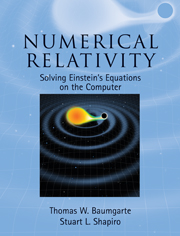Book contents
- Frontmatter
- Contents
- Preface
- Suggestions for using this book
- 1 General relativity preliminaries
- 2 The 3 + 1 decompostion of Einstein's equations
- 3 Constructing initial data
- 4 Choosing coordinates: the lapse and shift
- 5 Matter sources
- 6 Numerical methods
- 7 Locating black hole horizons
- 8 Spherically symmetric spacetimes
- 9 Gravitational waves
- 10 Collapse of collisionless clusters in axisymmetry
- 11 Recasting the evolution equations
- 12 Binary black hole initial data
- 13 Binary black hole evolution
- 14 Rotating stars
- 15 Binary neutron star initial data
- 16 Binary neutron star evolution
- 17 Binary black hole–neutron stars: initial data and evolution
- 18 Epilogue
- A Lie derivatives, Killing vectors, and tensor densities
- B Solving the vector Laplacian
- C The surface element on the apparent horizon
- D Scalar, vector and tensor spherical harmonics
- E Post-Newtonian results
- F Collisionless matter evolution in axisymmetry: basic equations
- G Rotating equilibria: gravitational field equations
- H Moving puncture representions of Schwarzschild: analytical results
- I Binary black hole puncture simulations as test problems
- References
- Index
I - Binary black hole puncture simulations as test problems
Published online by Cambridge University Press: 05 March 2013
- Frontmatter
- Contents
- Preface
- Suggestions for using this book
- 1 General relativity preliminaries
- 2 The 3 + 1 decompostion of Einstein's equations
- 3 Constructing initial data
- 4 Choosing coordinates: the lapse and shift
- 5 Matter sources
- 6 Numerical methods
- 7 Locating black hole horizons
- 8 Spherically symmetric spacetimes
- 9 Gravitational waves
- 10 Collapse of collisionless clusters in axisymmetry
- 11 Recasting the evolution equations
- 12 Binary black hole initial data
- 13 Binary black hole evolution
- 14 Rotating stars
- 15 Binary neutron star initial data
- 16 Binary neutron star evolution
- 17 Binary black hole–neutron stars: initial data and evolution
- 18 Epilogue
- A Lie derivatives, Killing vectors, and tensor densities
- B Solving the vector Laplacian
- C The surface element on the apparent horizon
- D Scalar, vector and tensor spherical harmonics
- E Post-Newtonian results
- F Collisionless matter evolution in axisymmetry: basic equations
- G Rotating equilibria: gravitational field equations
- H Moving puncture representions of Schwarzschild: analytical results
- I Binary black hole puncture simulations as test problems
- References
- Index
Summary
Simulating the late inspiral, merger and ringdown of a binary black hole was for many years the “holy grail” of numerical relativity. Dozens of researchers have spent many years attempting to formulate a stable algorithm capable of solving this important problem. As discussed in Chapter 13, several different techniques and corresponding codes now exist that can evolve coalescing binary black holes successfully. In this appendix we summarize two simulations in sufficient detail to enable the reader to assess the requirements and caliber of a typical computation. We employ one widely adopted method for the simulations, based on the BSSN evolution scheme and binary puncture initial data. The examples chosen here, and the quoted results, can be used as test problems for the construction of new algorithms and new modules.
We emphasize that performing a simulation of binary black hole coalescence provides a highly nontrivial and comprehensive laboratory for testing a 3 + 1 code capable of solving Einstein's field equations in vacuum in the strong-field regime of general relativity. It tests the caliber of not only the basic evolution scheme, but also the all-important diagnostic routines. These routines measure globally conserved quantities like the total mass and angular momentum of the system, the masses and spins of the individual black holes, the location and area of the black hole horizons, the asymptotic gravitational waveforms, the recoil kick imparted to the black hole remnant, and other “vital statistics” characterizing a dynamical spacetime containing black holes.
- Type
- Chapter
- Information
- Numerical RelativitySolving Einstein's Equations on the Computer, pp. 642 - 646Publisher: Cambridge University PressPrint publication year: 2010



